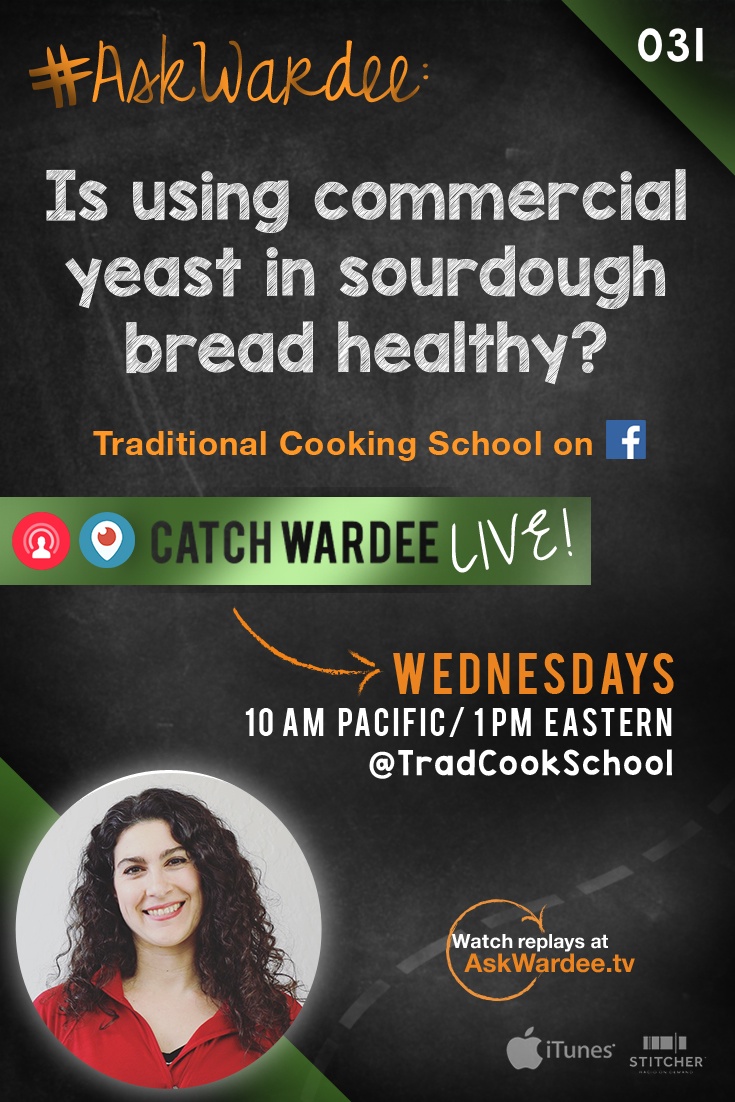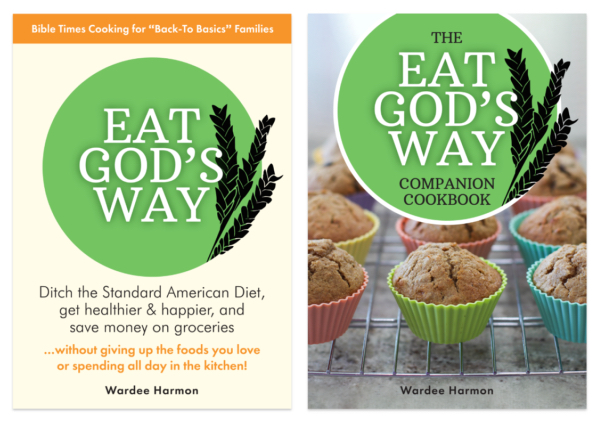
“Is using commercial yeast in sourdough bread healthy?” asks Cheri B. on today’s #AskWardee. I’m sharing my thoughts below!
I broadcast #AskWardee live each Wednesday at 10am Pacific (1pm Eastern) on Periscope and Facebook Live. Both the podcast and video replay of this week’s show are below. Enjoy!
Subscribe to #AskWardee on iTunes, Stitcher, YouTube, or the Podcasts app.
The Question: “Is using commercial yeast in sourdough bread healthy?”
Cheri B. asks:
“I have very much enjoyed all the info I’ve gotten from your site and the eCourses. Not only do you offer easy to understand instruction and know your craft, but you also have a kind, loving and gentle spirit. It is a joy to learn from you.
Although my family enjoys a hearty sourdough boule with hearty food, they very much dislike the sourdough taste in a sandwich loaf. I’m on a quest to make a nice, soft, digestible sandwich bread without the strongly developed sourdough taste. I’ve found I can manage a nice, delicately flavored loaf if I add some yeast to it and do a fast rise rather than overnight. However, I only feel half-good about that because, even though I’m using my sourdough starter and sprouted whole wheat flour to avoid the phytic acid, I am still adding commercial yeast. Is it unhealthy for us to eat bread with added commercial yeast on a regular basis? Thank you so much!
My Answer:
Because you’re sprouting your wheat to reduce phytic acid, you do not need a long rise time on your sourdough bread.
The long rise is for flour that hasn’t had any traditional method used at all. By long rise, I mean at least a total of 7 to 8 hours in a warm location in order to reduce phytic acid significantly and also to pre-digest gluten.
So, in your case, I think you’ve got the best of both worlds. The sourdough starter gets to work for whatever time “a fast rise” means for you (I’m not sure), and prior to that, the sprouting helped prepare your wheat for good digestion.
This doesn’t mean I think it’s as great as sourdough. Perhaps there are slight differences health wise, but I think you’re doing pretty well. I have heard that the acids in sourdough bread can help with digestion and you are not building up too much acid when you short-circuit the rising time. But in terms of phytic acid and pre-digestion of gluten, I think you’re ok.
Let’s get on the same page though…
I think it would be helpful to talk about some general things, too, so everyone is on the same page.
The traditional grain prep methods — soaking, sprouting, sourdough — neutralize phytic acid in the grain which would otherwise mess up our mineral absorption. That’s why we should take care to soak, sprout, or sour our bread products whenever possible. The prep methods also pre-digest gluten so it’s easier for our bodies to digest it.
By the way, the methods are effective in the order I listed, from least to most: soaking, sprouting, sourdough.
Cheri is combining both sprouting and sourdough (though shortened), so she’s probably ok with regard to the phytic acid and gluten. And her family gets a less sour bread!
On the other hand, if someone were to do what Cheri is doing without sprouting the wheat first (and milling into flour), it would not be as healthy as traditional sourdough. This is because the fast rise shortcuts the power of the sourdough starter, it’s not able to do its work fully — and there’s no sprouting to make up for that.
So yes, that bread is not as healthy.
By the way, here are my free instructions for starting your own sourdough starter.
Option #1
This Not-So-Dense (or Sour) Sourdough Bread from Tracey might be an option for you and others who are trying to get the benefits of sourdough without the sour flavor.
Tracey has done something similar to Cheri, except that she uses the other prep method (soaking) instead of sprouting and no commercial yeast.
This is a great option for those who are not able to sprout and mill their own flour, and the soaking is a bit simpler than sprouting. Tracey’s recipe has you soaking your flours overnight, before adding the starter, then using shortened souring/rising times with the starter. The result is not-so-sour (or dense) sourdough bread.
One of the commenters, Julia, says she is using sprouted flour in the recipe with “magnificent results“.
You might want to give that a try to see if you can get away from commercial yeast altogether!
Option #2
You could also try my no-knead einkorn sourdough recipe. The rise is enough for reduction in phytic acid. To neutralize sour flavor and boost rise, I add baking soda at the end (like the English Muffin Bread you tried).
In addition, einkorn flour has less phytic acid overall (as well as less starch and less and gentler form of gluten), so even though traditional methods are helpful, they are not quite as necessary as with modern wheat.
Here’s where you can grab the free recipe for the no-knead einkorn sourdough bread.
Links Mentioned:
- Not-So-Dense (Or Sour) Sourdough Bread
- Free Sourdough Starter Instructions
- Free No-Knead Artisan Sourdough Bread Recipe
- Traditional Cooking School eCourses
What Is The #AskWardee Show?
The #AskWardee Show is the live weekly show devoted to answering your niggling questions about Traditional Cooking: whether it’s your sourdough starter, your sauerkraut, preserving foods, broth, superfoods or anything else to do with Traditional Cooking or your GNOWFGLINS lifestyle.
I share tips and resources, plus answer your questions about Traditional Cooking!
The Details
When: Wednesdays at 10am Pacific / 1pm Eastern
Where: @TradCookSchool on Periscope or Traditional Cooking School on Facebook
What If You Can’t Make It?
Don’t worry. You can catch the replays or listen to the podcast!
- Come back here to AskWardee.TV; all replays will be up within hours of airing live; the print notes are always posted at the same time I go live.
- Follow @TradCookSchool on Periscope or Traditional Cooking School on Facebook to view the replay.
- Subscribe to the #AskWardee podcast on iTunes, Stitcher, YouTube, or the Podcasts app. While you’re there, be sure to leave a rating and review!
Want To Get YOUR Question Answered?
Here’s how to submit your question. If we answer it on #AskWardee, you’ll get a gift!
Or, you can…
- Tweet your question to @TradCookSchool on Twitter; use hashtag #AskWardee
- Send an email to wardee at AskWardee dot tv — add #AskWardee to your email so I know it’s for the show
Please do NOT add future questions for #AskWardee to the comments of this post because they might get missed!
What do you think? Is using commercial yeast in sourdough bread unhealthy? Have you ever made sourdough bread with sprouted flour?
...without giving up the foods you love or spending all day in the kitchen!

2 free books:
Eat God's Way
Ditch the Standard American Diet, get healthier & happier, and save money on groceries...
We only recommend products and services we wholeheartedly endorse. This post may contain special links through which we earn a small commission if you make a purchase (though your price is the same).


I have been using Tracey’s recipe and it is the best bread ever! It’s a beautiful bread and my family loves it!!!
Hi Wardee:
I have been successful by using recipes post here at using only sourdough like you say shorter periods for the fermenting. My delima is that when I use 100% whole Spelt with same exact recipe using my mixer for approx 4-6 minutes as I do with the whole wheat I consistently get lovely loaves of bread with a nice dome. For some reason, the spelt does not rise properly, and has no dome! – My 100% whole prairie gold wheat comes out with a nice dome and is soft and delicious. Not so my Spelt, its much denser and no dome. – I think part of it is that Spelt does not contain as much gluten but I don’t want to add gluten to it! Any suggestions?
Hi Maria,
Spelt will have less of a dome. What we would suggest is to use narrower and taller pans so it can’t spread out as much. And/or fill the pans fuller than you do for wheat. Here are some narrower bread pans, although they are non-stick: http://amzn.to/1Um4nOX
Millie
Traditional Cooking School